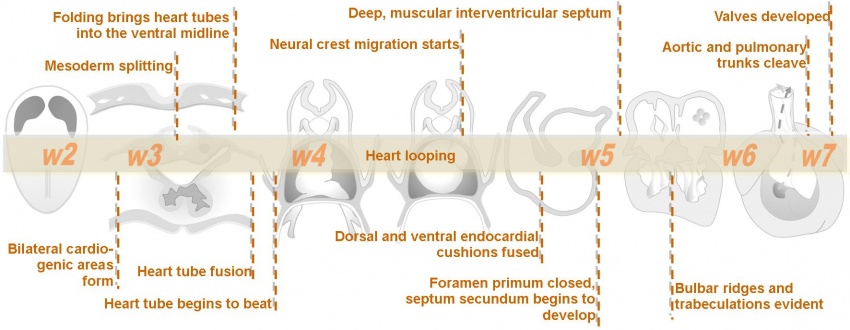Congenital Heart Disease (CHD) is a broad term for a variety of cardiac and vasculature prenatal defects. They affect about 8-10 of every 1,000 births in the United States. Heart and vascular abnormalities make up around 20% of all congenital malformations. Some of the more common abnormalities are outlined in the table below in order of frequency.
| Diagram
|
Abnormality
|
Epidemiology
|
Description
|
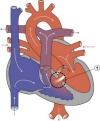
|
Ventricular Septal Defect
|
25% of CHD; more frequent in males
|
Growth failure of the membranous IV septum or endocardial cushions, resulting in a lack of closure of the IV foramen. 30-50% close spontaneously; large VSDs result in dyspnoea and cardiac failure in infancy.
|
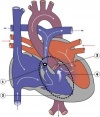
|
Tetralogy of Fallot
|
9-14% of CHD
|
Classic group of defects: pulmonary stenosis, VSD, dextroposition of aorta, RV hypertrophy. Results in cyanosis.
|

|
Transposition of the Great Vessels
|
10-11% of CHD
|
Aorta arises from the RV with the pulmonary trunk arising from the left. Most common cause of cyanotic heart disease in newborns; surgically corrected.
|
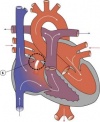
|
Atrial Septal Defect
|
6-10% of CHD; more common in females
|
Most commonly patent foramen ovale; can also be an ostium secundum defect, an endocardial cushion defect with ostium primum defect, sinus venosus defect, common atrium. Results in cyanosis due to right-to-left shunt.
|
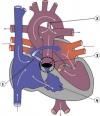 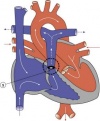
|
Pulmonary Atresia & Pulmonary Stenosis
|
10% of CHD
|
Unequal division of trunks causes cusps to fuse to form a dome with a narrow/non-existent lumen. Heart-lung transplantation may be the only therapy.
|
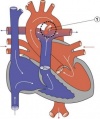
|
Patent Ductus Arteriosus
|
6-8% of CHD; 2-3 times more common in females; common in preterm newborns
|
Failure of contraction of the muscular wall of the DA. Spontaneous or surgical closure.
|

|
Aortic Stenosis
|
7% of CHD
|
Persistence of tissue that normally degenerates. Results in LV hypertrophy, heart murmurs.
|
 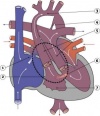
|
Hypoplastic Left Heart Syndrome
|
4-8% of CHD
|
RV maintains both pulmonary and systemic circulations aided by an ASD. Infants usually die within weeks.
|
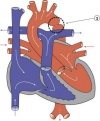
|
Coarctation of the Aorta
|
5-7% of CHD
|
Aortic constriction. Treatment aims at maintaining the ductus arteriosus via prostaglandins.
|
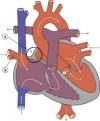 
|
Partial/Total Anomalous Pulmonary Venous Connection
|
<4% of CHD; more common in females
|
Total or partial lack of connection of the pulmonary veins with LA. They open into RA, one of the systemic veins or both. The overloaded pulmonary circuit leads to cyanosis, tachypnoea and dyspnoea. Treatment is via surgical redirection
|
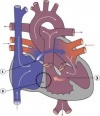
|
Tricuspid Atresia
|
1-3% of CHD
|
Complete lack of formation of the tricuspid valve with absence of direct connection between the right atrium and right ventricle. Results in cyanosis.
|

|
Double Outlet Right Ventricle
|
1-1.5% of CHD
|
Both large arteries arise wholly or mainly from the right ventricle. Arrangement of the atrioventricular valves and the ventriculoarterial connections are variable. Clinical manifestations variable.
|

|
Interrupted Aortic Arch
|
Very rare
|
Gap in ascending and descending thoracic aorta. Treated with prostaglandin to maintain ductus arteriosus followed by surgery.
|
Glossary Links
- Glossary: A | B | C | D | E | F | G | H | I | J | K | L | M | N | O | P | Q | R | S | T | U | V | W | X | Y | Z | Numbers | Symbols | Term Link
Heart terms
Atresia: Abnormal closure or absence of a body vessel or orifice.
Congenital heart disease: Abnormal structure or function of the heart due to a developmental defect arising prior to birth.
Cyanosis: Blue colouration of the skin and mucous membrane due to poor oxygenation of the blood.
Dyspnoea: Shortness of breath.
Heart murmur: Extra heart sounds appearing upon auscultation due to turbulent blood flow.
Hypertrophy: Increase in size of an organ or tissue due to enlargement of component cells.
Pulmonary circulation: Carries blood between the heart and lungs.
Stenosis: Abnormal narrowing of a blood vessel or orifice.
Systemic circulation: Carries oxygenated blood away from the heart to the other body organs and returns to the heart deoxygenated.
Tachypnoea: Abnormally rapid breathing rate.
